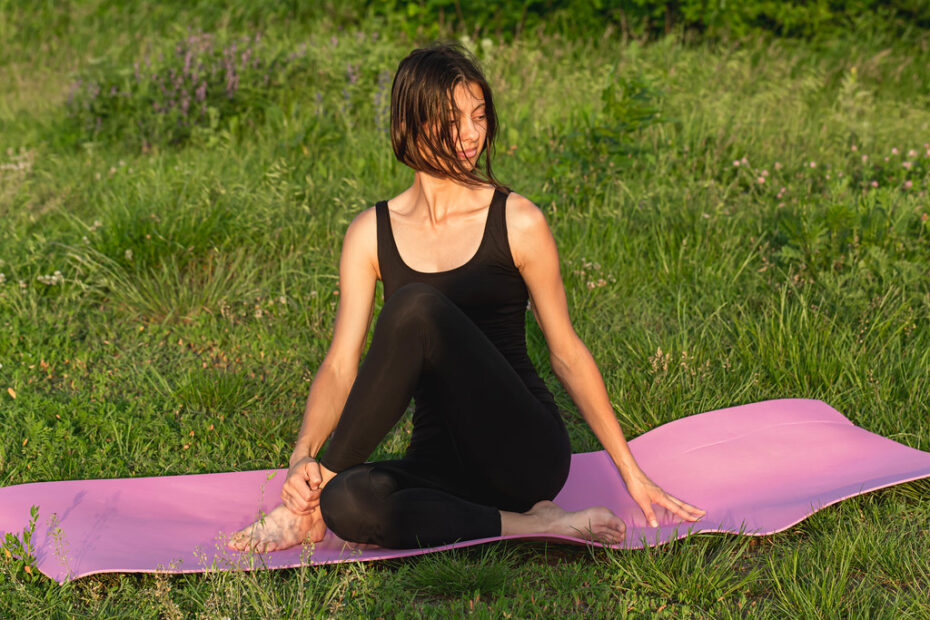This Posture Relieves Menstrual Discomfort and Resists Diabetes
Sedentary jobs take a toll on our hips, back, and neck. Ailments like frozen shoulder, tennis elbow, cramps in the hip, sciatica, slipped disc are all made acute by faulty sitting postures.
The Ardha Matsyendrasana, or the Fish Pose, is a yoga exercise that creates body resistance to such ailments. This exercise builds upon our normal movement of stretching by rotating our torso from the hip to ease ourselves from the cramps that develop when we sit in one position for a long time.
Such stretching of our hip is also a part of the warm-up before a workout session. We normally do this reflex action while standing, and when we do it we keep our feet rooted at the same spot while we twist our torso from our hip in a semi-circular movement.
How to Do the Ardha Matsyendrasana
Sit on a mat and extend your legs straight ahead from your hip. In this position, breathe normally. Place the palms of both hands on the mat to support you to keep your balance. Now lift your right leg, bend it at the knee and lift it over the knee of the left leg. Place your right foot beyond the knee of the left leg which is still kept straight. Place your right leg as near as possible to your left buttock.
After you fold your right leg, place the palm of your left hand on the foot of the right leg to hold it in place. Keep the palm of your right hand on the floor to balance yourself in the changed posture. In this asana you need to move your hands to support your torso to maintain your balance as you move your legs.
Now fold your left leg and place it at your right buttock. Hold your left foot firmly with the palm of your right hand. Now turn your shoulders and face as much towards the right side so that you can place your right knee under the arm pit of your left arm. Twist your torso from your hip. Some who do not want to stretch this much may place their right knee slightly away from the left armpit.
While doing the above steps your shoulders do naturally move towards the left side (along with the movement of your right leg over your left leg). But you have to twist them towards your right side to give the maximum twist to your abdomen.
The last step is to further rotate your hip and move your shoulders towards the right side as much as you can. Also rotate your neck and turn your face as much as possible to your right side to the extent possible.
Remember you move your shoulders and face in the direction of the hip joint of the leg that you have lifted.
You will experience considerable stretch at your hip, spine and neck. Your legs and arms too are stretched due to the twisting movement.
How to Exit the Ardha Matsyendrasana
Lift your hands and turn your face and shoulders to their original position i.e. with face forward. Lift your right leg and straighten it. Now make your left leg straight and place both legs in their original position of extending them straight from your hip.
Repeat this cycle of actions using alternate legs for as long as you feel comfortable. This is a difficult exercise to learn but once you master it, you enjoy its many benefits. In this exercise the repeated twists that you give to your right and left make this movement resemble the movements of a fish while swimming, hence the name “Fish Pose.”
Benefits of the Ardha Matsyendrasana
As your hip is rotated, your abdomen gets the maximum twist. As a result your kidneys too are nourished. This abdominal twist also has positive effects on the secretion from the various organs in the abdomen. There can be better secretion of insulin from the pancreas and bile from the liver. So there is better digestion and regulation of blood sugar. The small and large intestines also function better, thus helping your body to avoid constipation.
A Word of Advice
This is a difficult twisting exercise and learners would do well to try to master it gradually. Especially the movement of the right knee under the left armpit is a move that you can only master with days and weeks and maybe months of practice. So take your time to learn it.
Those with neck, spinal or hip injuries should not do this exercise. Do consult your doctor before you start doing this exercise and get your yoga teacher to guide up through the steps as you learn.
To derive comprehensive benefits from the different yoga exercises, do this exercise along with other yoga exercises like Bhujangasana, to improve your metabolism and digestion, the Akarna Dhanurasana along with the Normal Naukasana to make your back supple and to stimulate insulin secretion.
